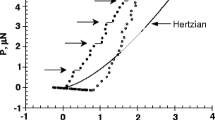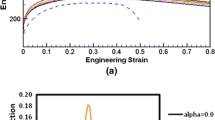The non-monotonous behavior of strength, activation volume, and pressure sensitivity parameter, as the grain size enters the nanoscale regime, is interpreted on the basis of a “rule of mixtures” argument, commonly used for composites. Grain interior and grain boundary spaces are treated as two independent “phases” with distinct mechanical properties. When the simple “rule of mixtures” argument is extended to incorporate concepts from the continuum theory of mixtures, the Laplacian of strain is generated in the local constitutive equation for each phase. A simple one-dimensional configuration for a nanopolycrystal is assumed and a related boundary value problem is solved to nterpret the dependence of the overall elastic modulus on the grain size.





Similar content being viewed by others
References
E. C. Aifantis, “Gradient nanomechanics: applications to deformation, fracture, and diffusion in nanopolycrystals,” Metall. Mater. Trans. A, 42, No. 10, 2985–2998 (2011).
J. E. Carsley, J. Ning, W. W. Milligan, et al., “A simple, mixtures-based model for the grain size dependence of strength in nanophase metals,” Nanostruct. Mater., 5, No. 4, 441–448 (1995).
D. A. Konstantinidis and E. C. Aifantis, “On the ‘anomalous’ hardness of nano-crystalline materials,” Nanostruct. Mater., 10, No. 7, 1111–1118 (1998).
V. G. Gryaznov, M. Y. Gutkin, A. E. Romanov, and L. I. Trusov, “On the yield stress of nanocrystals,” J. Mater. Sci., 28, No. 16, 4359–4365 (1993).
M. A. Meyers, A. Mishra, and D. J. Benson, “Mechanical properties of nano-crystalline materials,” Prog. Mater. Sci., 51, No. 4, 427–556 (2006).
M. Ke, S. A. Hackney, W. W. Milligan, and E. C. Aifantis, “Observation and measurement of grain rotation and plastic strain in nanostructured metal thin films,” Nanostruct. Mater., 5, No. 6, 689–697 (1995).
I. Ovid’ko and E. C. Aifantis, “Nanocrystals & nanomechanics: mechanisms & models. A selective review,” Rev. Adv. Mater. Sci., 35, No. 1-2, 1–24 (2013).
X. Zhang and K. E. Aifantis, “Interpreting the softening of nanomaterials through gradient plasticity,” J. Mater. Res., 26, No. 11, 1399–1405 (2011).
K. E. Aifantis and A. A. Konstantinidis, “Hall–Petch revisited at the nanoscale,” Mater. Sci. Eng. B, 163, No. 3, 139–144 (2009).
X. Zhang and K. E. Aifantis, “Accounting for grain boundary thickness in the sub-micron and nano scales,” Rev. Adv. Mater. Sci., 26, No. 1-2, 74–90 (2010).
J. R. Trelewicz and C. A. Schuh, “The Hall–Petch breakdown in nanocrystalline metals: a crossover to glass-like deformation,” Acta Mater., 55, No. 17, 5948–5958 (2007).
J. R. Trelewicz and C. A. Schuh, “The Hall–Petch breakdown at high strain rates: optimizing nanocrystalline grain size for impact applications,” Appl. Phys. Lett., 93, No. 17, 171916–171916-3 (2008).
H. Conrad, “Grain size dependence of the plastic deformation kinetics in Cu,” Mater. Sci. Eng. A, 341, No. 1-2, 216–228 (2003).
J. Chen, L. Lu, and K. Lu, “Hardness and strain rate sensitivity of nanocrystalline Cu,” Scripta Mater., 54, No. 11, 1913–1918 (2006).
X. H. Zhu, J. E. Carsley, W. W. Milligan, and E. C. Aifantis, “On the failure of pressure-sensitive plastic materials. Part I: Models of yield & shear band behavior,” Scripta Mater., 36, No. 6, 721–726 (1997).
J. E. Carsley, W. W. Milligan, X. H. Zhu, and E. C. Aifantis, “On the failure of pressure-sensitive plastic materials. Part II: Comparisons with experiments on ultra fine grained Fe–10% Cu alloys,” Scripta Mater., 36, No. 6, 727–732 (1997).
A. C. Lund and C. A. Schuh, “Strength asymmetry in nanocrystalline metals under multiaxial loading,” Acta Mater., 53, No. 11, 3193–3205 (2005).
T. D. Shen, C. C. Koch, T. Y. Tsui, and G. M. Pharr, “On the elastic moduli of nanocrystalline Fe, Cu, Ni, and Cu–Ni alloys prepared by mechanical milling/ alloying,” J. Mater. Res., 10, 2892–2896 (1995).
G. Palumbo, S. J. Thorpe, and K. T. Aust, “On the contribution of triple junctions to the structure and properties of nanocrystalline materials,” Scripta Metall. Mater., 24, No. 7, 1347–1350 (1990).
M. D. Kluge, D. Wolf, J. F. Lutsko, and S. R. Phillpot, “Formalism for the calculation of local elastic constants at grain boundaries by means of atomistic simulation,” J. Appl. Phys., 67, 2370–2379 (1990).
G. W. Nieman, J. R. Weertman, and R. W. Siegel, “Mechanical behavior of nanocrystalline Cu and Pd,” J. Mater. Res., 6, No. 5, 1012–1027 (1991).
J. Schiǿtz, T. Vegge, F. D. Di Tolla, and K. W. Jacobsen, “Atomic-scale simulations of the mechanical deformation of nanocrystalline metals,” Phys. Rev. B, 60, 11971–11983 (1999).
E. C. Aifantis, “On scale invariance in anisotropic plasticity, gradient plasticity and gradient elasticity,” Int. J. Eng. Sci., 47, No. 11-12, 1089–1099 (2009).
Acknowledgments
X. Zhang is grateful for the support of NSFC (11202172), CPSF (2013M530405), the Basic Application Research Plan of Sichuan Province (2015JY0239) and the Sichuan Provincial Youth Science and Technology Innovation Team (2013TD0004). The authors also acknowledge the support of Aristotle University through the Aristeia-II and Hellenic ERC-13 grants of the General Secretariat for Research and Technology (GSRT) of Greece.
Author information
Authors and Affiliations
Corresponding author
Additional information
Translated from Problemy Prochnosti, No. 4, pp. 157 – 167, July – August, 2015.
Rights and permissions
About this article
Cite this article
Zhang, X., Aifantis, E.C. Non-Monotonous Mechanical Behavior at the Nanoscale: Elastic and Plastic Properties. Strength Mater 47, 642–651 (2015). https://doi.org/10.1007/s11223-015-9700-9
Received:
Published:
Issue Date:
DOI: https://doi.org/10.1007/s11223-015-9700-9




